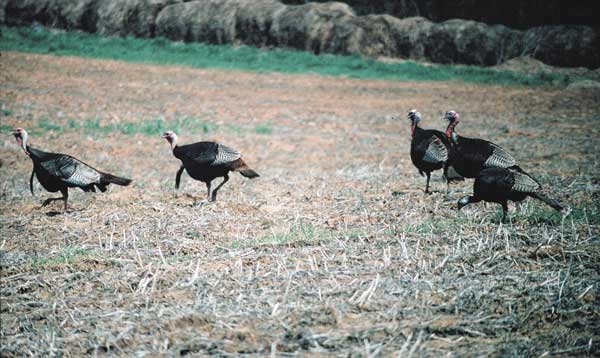
Three experts reveal tricks of the trade for bagging a dominant gobbler.
Age and maturity separate the men from the boys.
This concept seems to be true not only with humans, but with favored hunting targets, specificially white-tailed deer and wild turkey gobblers.
Give a whitetail buck a few years of growth, and he’ll typically sport a trophy rack and have a big body. These mature, wise animals also get more difficult to harvest with each passing season. The same is true for mature longbeard Eastern wild turkey gobblers.
While there’s nothing wrong with harvesting any gobbler that’s legal, if hunters want to target the dominant gobbler in the woods, they’ll need a game plan. Other than simply being lucky, hunters can do specific things to stack the odds in their favor when hunting a wise, old tom.
Travis Sumner has spent a lifetime learning how to target these wary woods wizards. Sumner is a professional turkey hunting guide and former wildlife biologist. His passion for managing wildlife, particularly deer and turkey, is matched only by his enthusiasm for hunting and harvesting them.
“One of the most difficult tasks any hunter can embark on is to try to harvest the dominane wild turkey in his area,” Sumner said. “But few things in the hunting world are more worthwhile than doing exactly that.”
Sumner said wild turkey gobblers may be created equal at birth, give or take a few genetic characteristics. But the “equal” part of that statement changes dramatically as they grow older. The older and more dominant the gobbler, the harder it is to end any hunt with that bird slung over a hunter’s shoulder.
“Sometimes I hate that I love to hunt dominant gobblers,” Sumner said. “Two-year-old birds have on too many occasions whipped me soundly through the years. But the three-year-and-older birds define the mystical and magical powers that are often associated with longbeards. I’m talking about birds that seem to appear then suddenly vanish.
“Plus, those gobblers seem to have the ability to see around corners. They really don’t have magical powers; they’re just the older birds that dominate their woods.
“These old gobblers are the most cautious animals in the woods, in my opinion. While they may strut majestically in the middle of an open field and honor your calling with frequent gobbles, they have learned the ways of their would-be assassins. Letting you know they’re there and allowing you kill them are two totally different things. The first doesn’t necessarily lead to the other.”
Paul Dickey is another veteran hunter who likes to pick on old gobblers. He has excellent calling and woodsmanship skills coupled with unlimited patience. Dickey is quick to give good advice on old longbeards.
“They’re tough, and you can’t allow yourself to get into a predictable pattern,” he said. “The first rule is to have no rules when hunting these birds. To consistently get in the game with these turkeys, you’ve got to react to situations with your gut instinct and work with a seat-of-your-pants philosophy.
“I’ve found my best and most memorable hunts are those where the old gobbler got to me in a personal way.”
Dickey said hunters first need to pinpoint where a dominant bird lives. He said the strength of a dominant gobbler lies in its role as king of the woods where he rules.
“If you only hear one or two birds gobbling in woods you know are full of turkeys, it’s quite possible you’re in the home range of a dominant gobbler,” he said. “The two-year-old birds are quiet because if they gobble or even look twice at a hen, the dominant gobbler will find them and thrash them.
“Take out the dominant bird, and the same woods may produce a half-dozen or dozen birds gobbling within a short period of time. Because the young gobblers fear the older bird, the dominant gobbler seldom gets in a hurry and seldom throws caution to the wind, even during the breeding season. Obviously, this makes them more difficult to kill.
“They also know every tree, bush, limb and stump in their territory. They’ll notice anything out of place.
“They most likely have had unpleasant experience with fake hen calling (hunters) and are much more cautious than 2-year-old birds. They’ve learned the hens will come to them when it’s breeding time, so they have unbelievable patience.”
However, Sumner said these birds also have a few weaknesses hunters can exploit.
First, they don’t particularly enjoy a situation in which a hen sounds ready to breed but shows no interest in coming to meet them.
“One situation that I use when guiding is to work as a team,” Sumner said. “A team of two hunters can sometimes exploit this weakness.
“If you get an old bird interested in your calls, but he refuses to approach, one hunter, who must be careful to stay out of sight, can slip away and call as he vacates the area. Don’t call aggressively. The calls should be subtle feeding and contented-hen calls. Calling with an ‘I’ll-see-ya-later-maybe’ attitude sums it up best.”
Sumner said the other hunter, the shooter, should remain at the last permanent calling position, sit stone still, using only his eyes to search for the gobbler. If the gobbler sounds off a couple of times and hushes, or if he just gets quiet as the decoy hunter slips away calling softly, odds are good the shooter will get to see the gobbler in short order.
Typically, the bird will approach the last place the faux hen called, which should put him in shotgun range.
“But beware. You’re now the hunted, and you’d better have the gun up and ready,” Sumner said.
Sumner said another weakness of boss gobblers is they often won’t tolerate a subordinate gobbler that attempts to breed with a hen.
“In public-land hunting, I never use the gobble call,” Sumner said. “It just isn’t worth the risk. But I have done so on private lands with excellent results. Often the boss gobbler will break and literally run like a rooster to flog a challenger if he thinks his dominance has been questioned.”
There are other ways to take advantage of jealous streaks in an old gobbler.
Mark Davis, another hunter who prefers to hunt dominant turkeys, describes a technique that requires great restraint on the part of the hunter.
“It requires great patience and maximum restraint, but you can use another live gobbler to help you take a dominant bird,” Davis said.
Davis said once he was working hard for a dominant gobbler and had the bird gobbling at his calls. But the old tom wouldn’t leave the safety of a hardwoods bottom where it had great open-woods vision.
“He would gobble at my calls but wouldn’t come,” Davis said. “While pondering where to move to flank him, I saw another gobbler sneaking in from the opposite direction. I really wanted the boss gobbler, so I let the 2-year-old bird get to within 15 yards. He looked all around for the hen he’d heard. Finally he clucked twice using the ol’ ‘where-are-ya?’ clucks gobblers use.
“I thought the clucks were fairly subtle. But they were answered immediately by a booming gobble that seem to strike fear into the 2-year-old. This gobbler had about ¾- inch spurs, a 9- or 10-inch beard and weighed in the 17-pound class.
“Within moments the dominant bird crested a slight rise from the hardwood bottom. Upon seeing the old bird approach, the second bird turned and ran at full speed. At this point, the boss gobbler went into full strut. Fortunately for me, he was also within (gun) range. I clucked softly, and he upped his periscope, presenting the shot I wanted.”
Sumner said there are more tricks a hunter can use to help his own cause.
“First, I believe that during a hunt for a boss gobbler, every aspect of what hunter does is orders of magnitude more important than it would be during a hunt for a 2-year old gobbler,” Sumner said. “That includes being still, calling well and setting up in the right place.
“I approach dominant birds with the overriding philosophy that they’re actively looking for a reason to break off the game. It’s not impossible to kill such a bird; it’s just that an almost paranoid attention to detail is needed.
“It’s my opinion that subtle calling is overwhelmingly the best tactic to use. Because a dominant turkey is the boss, he’s difficult to boss around, even by a lovelorn hen.
“When I hear a single bird or only few gobbles in the morning, I hedge my calling a bit, making it more subdued from the beginning. I can always heat up the calling if I need to for a specific gobbler.”
While other gobblers might sneak in while a hunter is working his calls at a boss gobbler, sometimes the big bird will come in for a look as well. However, they’re likely to walk cautiously and silently toward the sound of a hunter’s calls.
“Sometimes a dominant bird will gobble at my calls but not approach,” Sumner said. “Then, if I use the same call again and he doesn’t respond, the odds are good he’s coming in silently for a look.
“Unlike younger birds, these old guys often come in just close enough to peek around a bush or tree. They’re expecting to see a hen standing at the spot where a hunter is sitting.
“If a hunter is eagle-eye sharp, he often can spot the red-and-white head coloration (of a gobbler) and take him.
“In this way hunting boss gobblers is similar to hunting a big-racked buck. You often only have a window of opportunity for a few moments to take the trophy of a season, so you’d better be ready.”
Sumner also said when a silent boss tom is headed for a hunter, that’s an opportunity to use a decoy. The standard jake-on-the-hen scenario sometimes will cause an old gobbler to zoom in on a dead run and whip the tar out of a fake jake.
Sometimes just seeing a realistic-looking hen decoy will be enough to tempt him to walk near for a closer inspection.
Sumner uses the most-realistic hen decoys he can find. These decoys can be trouble to tote through the woods, but realism can be the key when targeting old birds.
He also advised hunters to be careful when setting up single or multiple decoys. They should be placed in such a position that if a gobbler comes in quietly for a look, he’ll be within gun range of a hunter when he first sees the decoy(s).
“I’ve seen instances where a gobbler saw the decoy, was completely fooled, but his dominant nature caused him to go into full strut and walk back and forth just out of range for an hour before turning and leaving, never offering a shot,” Sumner said.
When considering a setup, Dickey advised selecting one that offers a wide field of vision. An old gobbler may circle a hunter before he comes close, even if he’s gobbling, so a hunter needs to anticipate that possibility when he prepares his setup.
Sumner said he also has an ace up his sleeve in terms of calling.
“I love to actively call a turkey, but sometimes the most deadly call is to lay a dose of silence on him,” Dickey said. “I don’t dare suggest to know what a turkey is thinking, but sometimes it appears curiosity gets the better of them.
“A gobbler occasionally just has to come see if the hen really had the audacity to leave while in the midst of conversation. It’s worked often enough that I’m forced to use this tactic occasionally. Although I prefer to be talking to the turkey, I find solace in the fact that I consider silence a woodsmanship skill.”
Sumner suggested another tactic that has worked well on occasion for dominant birds.
“If you know the woods really well, you can sometimes anticipate where a gobbler is headed,” he said. “I began to use this tactic because so many times a dominant gobbler would gobble in reply to my calls, but then he just walked away.
“I suppose he was headed to wherever he was going to begin with. If you can figure out where that targeted spot is and get set up close to his route, he may change course slightly to check out a couple of clucks or purrs.
“It’s essential to not over call in this situation. Instead, call like you’re a hen that doesn’t know or care the boss gobbler is around.”
Dickey’s final advice is simple — use lots of patience.
“Almost every successful hunt for a dominant gobbler will begin and end with patience,” he said. “Don’t let the nature of an old gobbler force you into errors. That’s one of his strengths hunters must turn to their advantage to be consistently successful.
“If you want to hunt an old gobbler, accept that your hunt may not begin and end on the same day. Some folks get hung up all season on a boss gobbler. The key is to have a game plan and work that plan with patience and persistence. Those are two of the best allies you can employ.
“If you get frustrated and have that hard-to-resist urge to make a do-or-die move, it usually won’t be the boss gobbler that does the dying.”
In reality, dominant gobblers can’t vanish, can’t see through trees or over the top of ridges. During the spring mating season, they want a good love life — but on their own terms.
Similar to a hen a hunter mimics, boss gobblers may not be easy, but they can be had.
After all, they’re just turkeys.

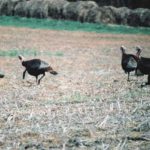
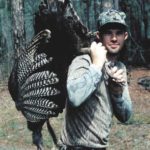
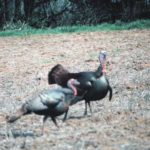
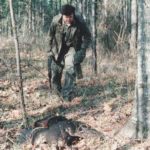
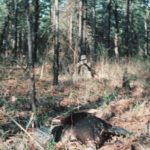
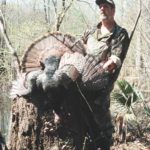



Be the first to comment